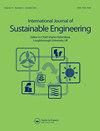Carbon capture, sequestration, and usage for clean and green environment: challenges and opportunities
IF 3.6
Q3 GREEN & SUSTAINABLE SCIENCE & TECHNOLOGY
International Journal of Sustainable Engineering
Pub Date : 2023-09-13
DOI:10.1080/19397038.2023.2256379
引用次数: 0
Abstract
The capture of carbon and sequestration (CCS) activity is considered strategic in the context of world energy policy. In fact, CO2 emissions from fossil/conventional-fuel-fired power plants can be lowered by using CCS on the same. Various other methods have been developed to date to capture the carbon and store it. This article focuses on the various carbon capture technologies and the storage technologies such as pre-combustion, post-combustion, oxyfuel technology, and direct air capture (DAC) technology, including their subparts, along with the factors affecting the carbon capture technologies. The aim of the present study is to develop an overview of carbon dioxide removal (CDR) technologies and CO2 sequestration, including a vast coverage of the various factors that have a huge impact on CCS. It emerged that the existing technologies that deal with CO2 sequestration and capture are being used at large scale to produce derivatives including chemicals, polymers, building materials, and various other products. The newest technology that has been seen creating a huge effect is direct air capture, and commercial use of such technologies has been seen. Future potential application areas have been realised in this review work. In addition, this article explores policy recommendations for the future.碳捕获、固存和清洁绿色环境的利用:挑战与机遇
在世界能源政策的背景下,碳捕获和封存(CCS)活动被认为是战略性的。事实上,化石燃料/传统燃料发电厂的二氧化碳排放量可以通过使用CCS来降低。到目前为止,已经开发了各种其他方法来捕获碳并储存它。本文重点介绍了各种碳捕集技术和存储技术,如燃烧前技术、燃烧后技术、氧燃料技术和直接空气捕集(DAC)技术,以及它们的子技术,以及影响碳捕集技术的因素。本研究的目的是概述二氧化碳去除(CDR)技术和二氧化碳封存,包括对CCS产生巨大影响的各种因素的广泛覆盖。人们发现,目前处理二氧化碳封存和捕获的技术正被大规模用于生产衍生物,包括化学品、聚合物、建筑材料和各种其他产品。最新的技术是直接空气捕捉,这种技术产生了巨大的影响,并已被用于商业用途。在综述工作中发现了未来潜在的应用领域。此外,本文还探讨了未来的政策建议。
本文章由计算机程序翻译,如有差异,请以英文原文为准。
求助全文
约1分钟内获得全文
求助全文
来源期刊

International Journal of Sustainable Engineering
GREEN & SUSTAINABLE SCIENCE & TECHNOLOGY-
CiteScore
7.70
自引率
0.00%
发文量
19
 求助内容:
求助内容: 应助结果提醒方式:
应助结果提醒方式:


